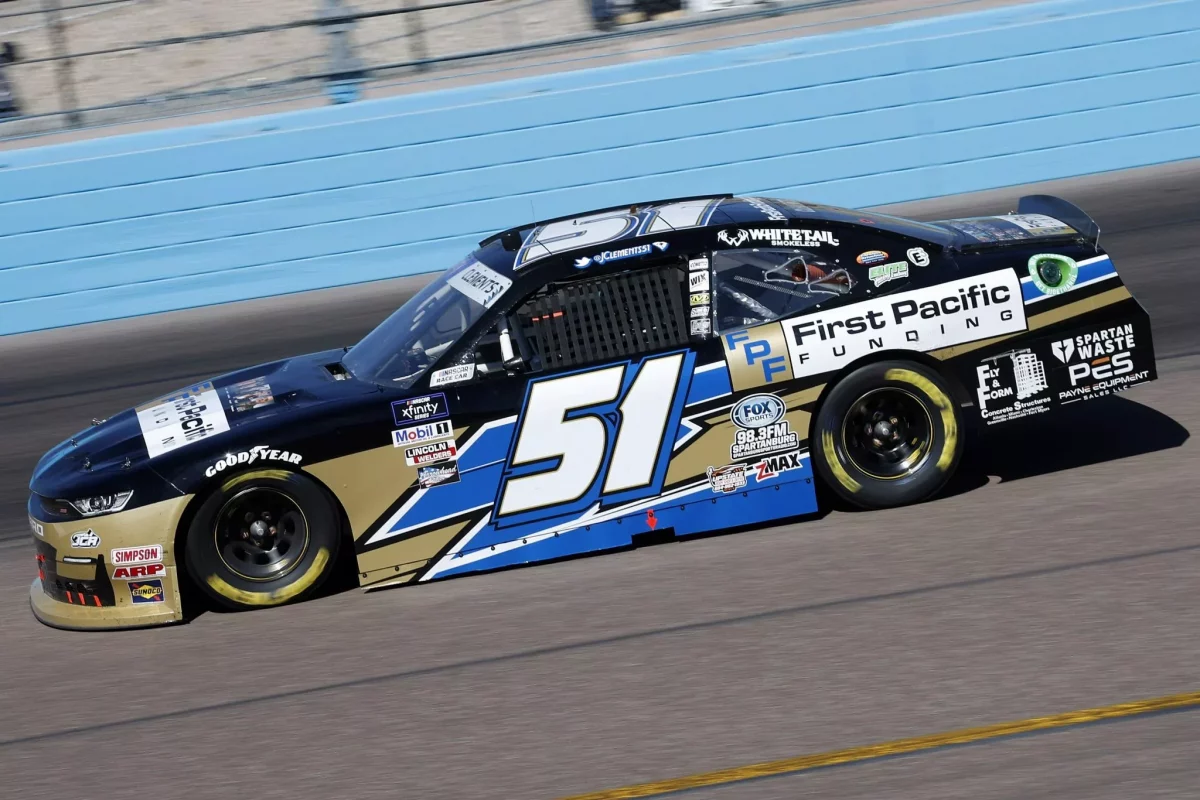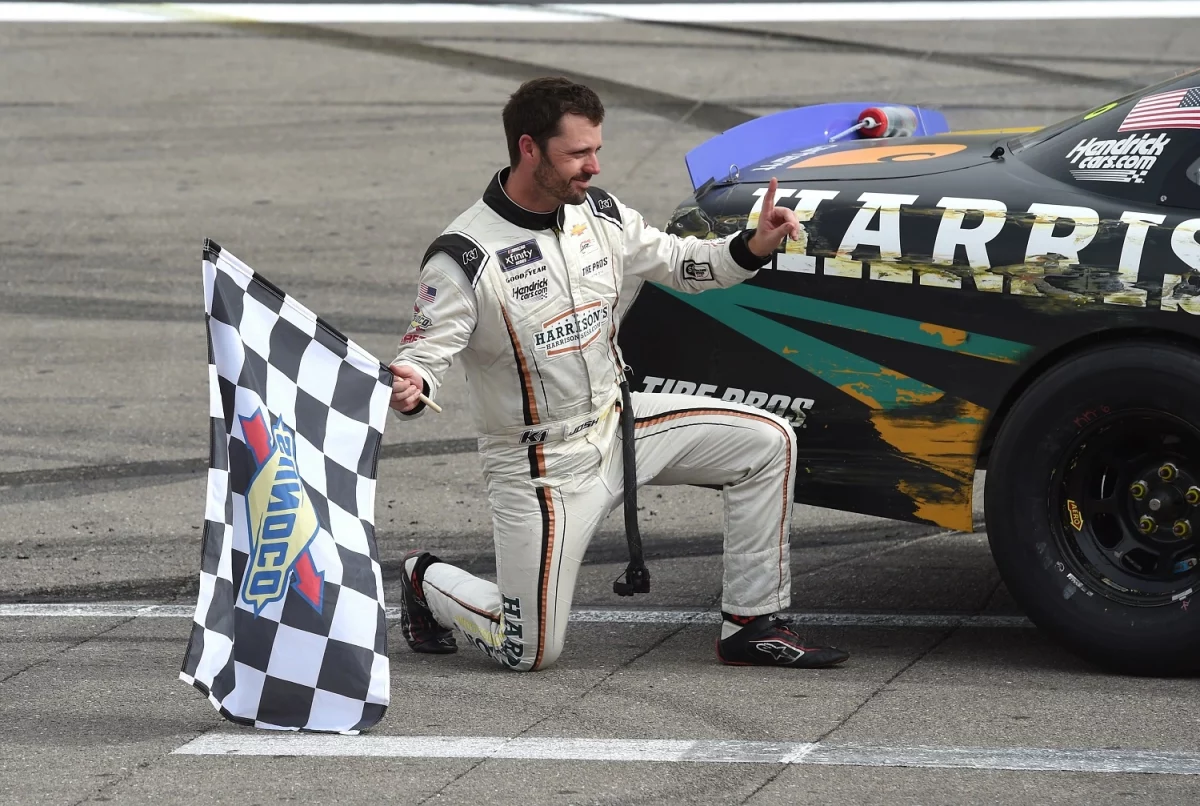By Matt Weaver, Special Contributor
For the first time in six years, NASCAR has made a significant change to the Xfinity Series rules package, one designed to increase relative parity and reduce the visual affect known as crab-walking.
To force teams back towards straighter bodies on the straights and entering the corner, NASCAR has ordered teams back to a 51″ truck arm from the 45″ they used the past several seasons.
While the racing has been extremely compelling during that time, JR Motorsports and Joe Gibbs Racing has especially separated themselves from the pack. Teams had figured out how to get skew built back into their cars by bending the truck arms in a beneficial way.

The skew effectively helped cars cut through the corner and make downforce but in a visually polarizing way. That’s to say nothing of creating competitive separation. While there will be immediate slight changes to the racing product in the Xfinity Series, the expectation is that teams will find ways to get that downforce, sideforce and overall grip back.
2020 Truck Series champion and Richard Childress Racing driver Sheldon Creed detailed what he experienced from the January 30 open test at Charlotte Motor Speedway.
“So far, it seems like overall less grip, less rear grip,” Creed said. “That’s the main difference. For example, our car is decent on entry, but you have to be nice and patient with it because we’re all fighting rear grip now.
The Xfinity car was already harder to drive and now, it’s even more of a handful. There will be a lot less throttle time, which I think will make it fun, but it’s going to race a little worse in the air, I think, based on how we’re fighting to find grip, but I think we’ll eventually get it back. But it’s going to be interesting the first few races.”
Daniel Hemric, who won the 2021 Xfinity Series championship driving for Joe Gibbs Racing and now drives for Kaulig Racing, expects the cars to drive closer to the 750 spacer, low downforce rules package used by the Cup Series from 2016-to-2018.
“One thing that initially sticks out to be is that corner entry speed seems up because the cars are straighter and not as draggy down the straightaway,” Hemric said. “That being the case, some of the things we’ve seen, 2016, 2017 and 2018 lower downforce Cup stuff.
“It has the feel of that where corner entry speeds are up, mid-corner speeds are down and because of that, it gets hurt in traffic a little worse.
“I know some of the moments have felt drastically different from years past. We’re trying to wrap our heads around that. But the pure yaw moment, visually how the cars track down the straighaway and that first turn in off the wall, that really changes a lot of the feel with what’s changed in the car. Race teams and engineers are all smart individuals and will work to try to get some of that back. In the grand scheme of things, it is a change.”

Xfinity Series team owner, and occasional Truck Series driver, Jordan Anderson said it’s forced his smaller team to thrash to get ready for all the changes.
“From a team standpoint, the biggest thing NASCAR wanted to see is taking away some of the crab walking you see on TV, the cars looking sideway and to take some of the skew out of the cars so we went to the 51″ truck arm from the 45″ we’ve used the past few seasons and they’ve adjusted the rear end housing,” Anderson said. “The cars are straighter.
“The biggest thing we heard from both of our drivers, we had Jeb (Burton) from the morning to 2:30 to 3:00 and then we had Parker (Retzlaff) after 3:00 for a long run.
“They said they’re tighter turning off the wall and looser going down the hill because the car has less skew to turn it on the race track. It’s been a little bit of a mad dash because we’re a new team, so we didn’t have the inventory from six or seven years ago. We had to get the 51″ truck arms made and delivered and build the new rear end housing to fit the rules.”
At least at first, the cars could be so difficult to drive in traffic, that it could actually stifle passing. In the final hour of the test at Charlotte, Sammy Smith in a Joe Gibbs Racing Toyota pulled out on sticker tires behind Jeremy Clements on 20 lap old tires and could not complete the pass.
“As of now, and maybe it will change once we figure it out better, but it’s going to be a handful, especially around other cars,” Clements said. “Last year, we would be loose in, tight center and off.
“Now, we’re the opposite. We’re tight in, loose center-off and if you miss the bottom, you can really screw up, you have to put a lot of wheel in it to catch it. It’s a handful.
“There at the end, we did a 20-lap run. The 18 came out behind me and he had stickers on and I had 19 laps scuffs and he let me get a gap. He caught me and couldn’t pass me. I finally let him go but man, it seemed like it was very difficult for him to pass me even though he had 19 lap fresher tires on.
“I think it’s going to be a handful when we barrel off into Turn 1 together in all that dirty air.”
Because it’s forced teams to buy brand new truck arms and rear-end housings, Clements says he’s not entirely sure what NASCAR was hoping to accomplish given the popularity of the racing product and the competition platform.
“I don’t know what we were trying to achieve really,” Clements said. “It’s what we got. Hopefully we can make the best of it and find what our Chevrolet is like but it’s going to be a challenge to say the least.
“We spent a lot more money this offseason buying new rear ends, new truck arms, mounts for the track bar, stuff we already had. But that’s part of the deal.
“We actually learned a lot from when we lost an hour when the left side truck arm mount broke and we had to fix it and realize it might need to be heat-treated and it might need more bracing on it.
“So, I guess it’s good we broke it in a test as opposed to a race trying to tighten it up, move it down and it breaks during a race, crash the car. Now we have to take our new truck arms and take them back to the builder and say here’s the problem and to fix them, so we learned a lot. We threw a lot at this car and hopefully we found a direction to be in when we come back here to race.”

Josh Berry made it to the championship race last year for JR Motorsports. And while he believes teams will eventually make it better, he also hopes it doesn’t long-term affect the racing product worse from what it’s been the past half-decade.
“The cars are a bit more of a handful,” Berry said. “I think it directionally went how I thought it would. We’ll get our arms around the package and get it better over time.
“I’m curious to see how it’s going to be in traffic from what it’s been the past few years because our racing has been as good in that series as anything I can remember. I think everyone will get their arms around it and at the end of the day, it’s the same for everyone.”
That was the sentiment from Hemric too.
“I don’t necessarily think it’s going to drastically change the racing,” Hemric said. “In the seat, the best teams are going to rise to the moment.
“It’s not going to be like the Next-Gen Cup car and bring teams that don’t traditionally compete into the fold, but I think it’s going to narrow the box from the teams who really figured it out and bring them back a little bit. Over time, the best teams figure out how to do it better than the next guys. It could be a learning curve the first part of the season though.”











Connect with Us
To RSS Feed
Followers
Likes